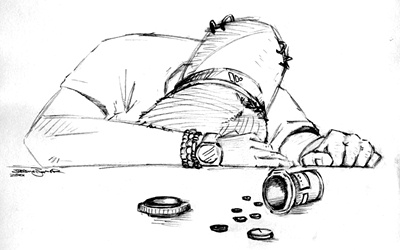All Nonfiction
- Bullying
- Books
- Academic
- Author Interviews
- Celebrity interviews
- College Articles
- College Essays
- Educator of the Year
- Heroes
- Interviews
- Memoir
- Personal Experience
- Sports
- Travel & Culture
All Opinions
- Bullying
- Current Events / Politics
- Discrimination
- Drugs / Alcohol / Smoking
- Entertainment / Celebrities
- Environment
- Love / Relationships
- Movies / Music / TV
- Pop Culture / Trends
- School / College
- Social Issues / Civics
- Spirituality / Religion
- Sports / Hobbies
All Hot Topics
- Bullying
- Community Service
- Environment
- Health
- Letters to the Editor
- Pride & Prejudice
- What Matters
- Back
Summer Guide
- Program Links
- Program Reviews
- Back
College Guide
- College Links
- College Reviews
- College Essays
- College Articles
- Back
Addiction
“Addiction is a condition that results when a person ingests a substance or engages in an activity that can be pleasurable but the continued use/act of which becomes compulsive and interferes with ordinary life responsibilities” (Psychology Today). It can be caused by many outside factors, most of them being stress in one’s personal life. Addiction can be broken down into two categories, physical and psychological dependence.
The first type, physical addiction, is when the body develops a physiological reliance on the drug because the drug changed the natural state of being in the body. The most common drugs that cause physiological dependence are opioids, tobacco and alcohol. In the example of opioids, use of substances such as heroin “create a tolerance”, meaning “more of the drug is needed” to achieve the same “high” or “rush” (Boynton Health). More examples of physiological change due to heroin are affected hormonal and neuronal systems in the brain, causing long term imbalances (National Institute on Drug Abuse). It also causes deterioration in the white matter area of the brain, meaning it affects decision-making, dealing with stress and the ability to regulate behavior.
The second type, psychological dependence, affects a person mentally and emotionally, in addition to/or rather than physically. Drugs that cause mental and emotional effects are generally cocaine and amphetamines. Amphetamines, such as adderall, can cause “aggressive and paranoid hostility” as well as “hallucinations” which can lead to violent behavior (Narconon). One drug that I have personal experience with, thanks to my mother’s use is tobacco, specifically cigarettes. I’ve seen on several occasions that when the brain is craving the nicotine in the cigarettes, it causes impatience, anger and stress in the body, which can lead to potentially, but very rarely, violent outbursts.
One of the most common reasons to begin substance abuse, leading to addiction, is stress. Stress either in one’s personal life, such as relationships, family, work and financial situations. For adolescents, many reasons such as trauma, impulse control and mental and behavioral problems all cause increased possibility of substance abuse. A more stress related reason for adolescents, trouble in the family and at home can cause huge amounts of stress, prompting substance abuse. This can be bad, as substance abuse in adolescents showed that they were more resistant to treatment and more liable to relapse.
The causes are clear, and we’ve explored some of the effects of drugs, however they can also affect other people’s lives around them, as well as their own lives in many different ways. Studies have shown that substance use in parents of children cause a higher chance of substance abuse in the children (Drugfree). Another effect, can be change in behavior of the abusee. Due to the intense craving for the drug, they might react abnormally, causing irrational decision making. Personally, my mother can’t even watch movies anymore due to her cigarette addiction, she hates closed spaces and needs to smoke every 2-3 hours. Finally, as mentioned above, it can cause an interference to their life, and in more severe occasions, it can cause disruptions in functioning as a part of society.
Addiction in media has multiple different portrayals. Starting in 1930, tobacco advertising became much more mainstream. Many major medias such as movies and magazines contained advertisements for tobacco, depicting it as trending and desirable to smoke. However, in the 1960s and onward, a retaliation against tobacco advertising began, with newfound studies on effects of tobacco use. In 1969, the Public Health Cigarette Smoking Act was passed to display medical warnings on cigarette packets and ban tv and radio advertising of cigarettes in the United States (Center of Disease Control and Prevention). In most movies today, addiction to drugs such as heroin is depicted as negative, with valid reasoning. However, for other drugs such as marijuana, it is seen to be used a lot as recreational and enjoyed by seemingly anyone, regardless of class. Drugs such as cocaine also have negative depictions, however due to the high prices, 60-80 dollars in the U.S, they show that it isn’t a cheap drug, meaning you’d have to be stable financially to use a lot of it actively (Alternet). An example of the latter is the movie “Wolf of Wall Street” “Based on the true story of Jordan Belfort, from his rise to a wealthy stock-broker...to his fall involving crime, corruption and the federal government.” directed by Martin Scorsese (IMDB).
Addiction as a whole is very controversial, by definition and regard by people. It has been a huge thing for as long as habit forming substances and activities have existed. The two types of addiction, physical and psychological both have various mental and physiological effects. Today, many drugs and habit forming activities can cause addiction and can have major impacts on people's’ lives.

Similar Articles
JOIN THE DISCUSSION
This article has 0 comments.
